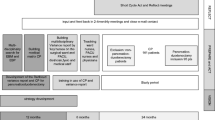Abstract
Background: When implemented in several common surgical procedures, clinical pathways have been reported to reduce costs and resource utilization, while maintaining or improving patient care. However, there is little data to support their use in more complex surgery. The objective of this study was to determine the effects of clinical pathway implementation in patients undergoing elective pancreaticoduodenectomy (PD) on cost and resource utilization.
Methods: Outcome data from before and after the development of a clinical pathway were analyzed. The clinical pathway standardized the preoperative outpatient care, critical care, and postoperative floor care of patients who underwent PD. An independent department determined total costs for each patient, which included all hospital and physician costs, in a blinded review. Outcomes that were examined included perioperative mortality, postoperative morbidity, length of stay, readmissions, and postoperative clinic visits.
Results: From January, 1996 to December, 1998, 148 consecutive patients underwent PD or total pancreatectomy; 68 before pathway development (PrePath) and 80 after pathway implementation (PostPath). There were no significant differences in patient demographics, comorbid conditions, underlying diagnosis, or use of neoadjuvant therapy between the two groups. Mean total costs were significantly reduced in PostPath patients compared with PrePath patients ($36,627 vs. $47,515; P = .003). Similarly, mean length of hospital stay was also significantly reduced in PostPath patients (13.5 vs. 16.4 days; P = .001). The total cost differences could not be attributed solely to differences in room and board costs. Cost and length-of-stay differences remained when outliers were excluded from the analysis. Despite these findings, there were no significant differences between PrePath and PostPath patients in terms of perioperative mortality (3% vs. 1%), readmissions within 1 month of discharge (15% vs. 11%), or mean number of clinic visits within 90 days of discharge (3.3 vs. 3.4 visits).
Conclusions: The establishment of a clinical pathway for PD patients dramatically reduced costs and resource utilization without any apparent detrimental effect on quality of patient care. These findings support the implementation of clinical pathways for PD patients, as well as investigation into pathway care for other complex surgical procedures.
Similar content being viewed by others
References
Gerszten PC. Outcomes research: a review. Neurosurgery 1998;43:1146–1156.
Zander K. Nursing case management: strategic management of cost and quality outcomes. J Nurs Admin 1988;18:23–30.
Huber TS, Carlton LM, Harward TRS, et al. Impact of a clinical pathway for elective infrarenal aortic reconstructions. Ann Surg 1998;227:691–701.
Stanley AC, Barry M, Scott TE, et al. Impact of a critical pathway on postoperative length of stay and outcomes after infrainguinal bypass. J Vasc Surg 1998;27:1057–1065.
Bradshaw BGG, Liu SS, Thirlby RC. Standardized perioperative care protocols and reduced length of stay after colon surgery. J Am Coll Surg 1998;166:501–508.
Warner BW, Kulick MM, Stoops MM, et al. An evidence-based clinical pathway for acute appendicitis decreases hospital duration and cost. J Pediatr Surg 1998;33:1371–1375.
Pitt HA, Murray KP, Bowman HM, et al. Clinical pathway implementation improves outcomes for complex biliary Surgery. Surgery 1999;126:751–758.
Davidson BS, Lee JE, Pisters PWT, Ames FC, Evans DB. Teaching complex surgery: a standardized approach to pancreaticoduodenectomy. Surgical Rounds 1995;16:450–457.
Evans DB, Lee JE, Pisters PWT. Pancreaticoduodenectomy (Whipple Operation) and Total Pancreatectomy for Cancer. In. Nyhus LM, Baker RJ, Fisher JF, eds. Mastery of Surgery, 3rd ed. Boston: Little Brown and Co., 1997:1233–1249.
Hofman PA. Critical path method: an important tool for coordinating clinical care. J Qual Improvement 1993;19:235–246.
Horne M. Involving physicians in clinical pathways: an example for perioperative knee arthroplasty. J Qual Improvement 1996;22:115–124.
Pearson SD, Goulast-Fisher D, Lee TH. Critical pathways as a strategy for improving care: problems and potential. Ann Intern Med 1995;123:941–948.
Hoffman PA. Critical path method: an important tool for coordinating clinical care. J Qual Improvement 1993;19:235–246.
Muluk SC, Painter L, Sile S, et al. Utility of clinical pathway and prospective case management to achieve cost and hospital stay reduction for aortic aneurysm surgery at a tertiary care hospital. J Vasc Surg 1997;25:84–89.
Calligaro KD, Dougherty MJ, Raviola CA, Musser DJ, DeLarentis JJ. Impact of clinical pathways on hospital costs and early outcome after major vascular surgery. J Vasc Surg 1995;22:649–660.
Collier PE. Do clinical pathways for major vascular surgery improve outcomes and reduce costs? J Vasc Surg 1997;26:170–185.
Pritts TA, Nussbaum MS, Flesch LV, Fegelman EJ, Parikh AA, Fischer JE. Implementation of a clinical pathway decreases length of stay and cost for bowel resection. Ann Surg 1999;230:728–733.
Archer SB, Burnett RJ, Flesch LV, et al. Implementation of a clinical pathway decreases length of stay and hospital charges for patients undergoing total colectomy and ileal pouch/anal anastomosis. Surgery 1997;122:699–705.
Sosa JA, Bowman HM, Gordon TA, et al. Importance of hospital volume in the overall management of pancreatic cancer. Ann Surg 1998;228:429–438.
Simunovic M, To T, Theriault M, Langer B. Relation between hospital surgical volume and outcome for pancreatic resection for neoplasm in a publicly funded health care system. CMAJ 1999;160:643–648.
Begg CB, Cramer LD, Hoskins WJ, Brennan MF. Impact of hospital volume on operative mortality for major cancer surgery. JAMA 1998;280:1747–1751.
Birkmeyer JD, Finlayson SRG, Tosteson ANA, et al. Effect of hospital volume on in-hospital mortality with pancreaticoduodenectomy. Surgery 1999;125:250–256.
Lieberman MD, Kilburn H, Lindsey M, Brennan MF. Relation of perioperative deaths to hospital volume among patients undergoing pancreatic resection for malignancy. Ann Surg 1995;222:638–645.
Becker EL, Landau SI, eds. International Dictionary of Medicine and Biology. Vol. 1. New York: Wiley Medical Publications, 1986:905.
Yeo CJ, Cameron JL, Sohn TA. Six hundred fifty consecutive pancreaticoduodenectomies in the 1990s: pathology, complications, and outcomes. Ann Surg 1997;226:248–257.
Holbrook RF, Hargrave K, Traverso W. A prospective cost analysis of pancreaticoduodenectomy. Am J Surg 1996;171:508–511.
Author information
Authors and Affiliations
Corresponding author
Rights and permissions
About this article
Cite this article
Porter, G.A., Pisters, P.W.T., Mansyur, C. et al. Cost and Utilization Impact of a Clinical Pathway for Patients Undergoing Pancreaticoduodenectomy. Ann Surg Oncol 7, 484–489 (2000). https://doi.org/10.1007/s10434-000-0484-0
Received:
Accepted:
Issue Date:
DOI: https://doi.org/10.1007/s10434-000-0484-0




